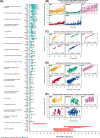The Signal and the Noise: Characteristics of Antisense RNA in Complex Microbial Communities
- PMID: 32047059
- PMCID: PMC7018526
- DOI: 10.1128/mSystems.00587-19
The Signal and the Noise: Characteristics of Antisense RNA in Complex Microbial Communities
Abstract
High-throughput sequencing has allowed unprecedented insight into the composition and function of complex microbial communities. With metatranscriptomics, it is possible to interrogate the transcriptomes of multiple organisms simultaneously to get an overview of the gene expression of the entire community. Studies have successfully used metatranscriptomics to identify and describe relationships between gene expression levels and community characteristics. However, metatranscriptomic data sets contain a rich suite of additional information that is just beginning to be explored. Here, we focus on antisense expression in metatranscriptomics, discuss the different computational strategies for handling it, and highlight the strengths but also potentially detrimental effects on downstream analysis and interpretation. We also analyzed the antisense transcriptomes of multiple genomes and metagenome-assembled genomes (MAGs) from five different data sets and found high variability in the levels of antisense transcription for individual species, which were consistent across samples. Importantly, we challenged the conceptual framework that antisense transcription is primarily the product of transcriptional noise and found mixed support, suggesting that the total observed antisense RNA in complex communities arises from the combined effect of unknown biological and technical factors. Antisense transcription can be highly informative, including technical details about data quality and novel insight into the biology of complex microbial communities.IMPORTANCE This study systematically evaluated the global patterns of microbial antisense expression across various environments and provides a bird's-eye view of general patterns observed across data sets, which can provide guidelines in our understanding of antisense expression as well as interpretation of metatranscriptomic data in general. This analysis highlights that in some environments, antisense expression from microbial communities can dominate over regular gene expression. We explored some potential drivers of antisense transcription, but more importantly, this study serves as a starting point, highlighting topics for future research and providing guidelines to include antisense expression in generic bioinformatic pipelines for metatranscriptomic data.
Keywords: RNAseq; antisense RNA; cis-antisense RNA; meta-analysis; metatranscriptomics; review.
Copyright © 2020 Michaelsen et al.
Figures


References
LinkOut - more resources
Full Text Sources
